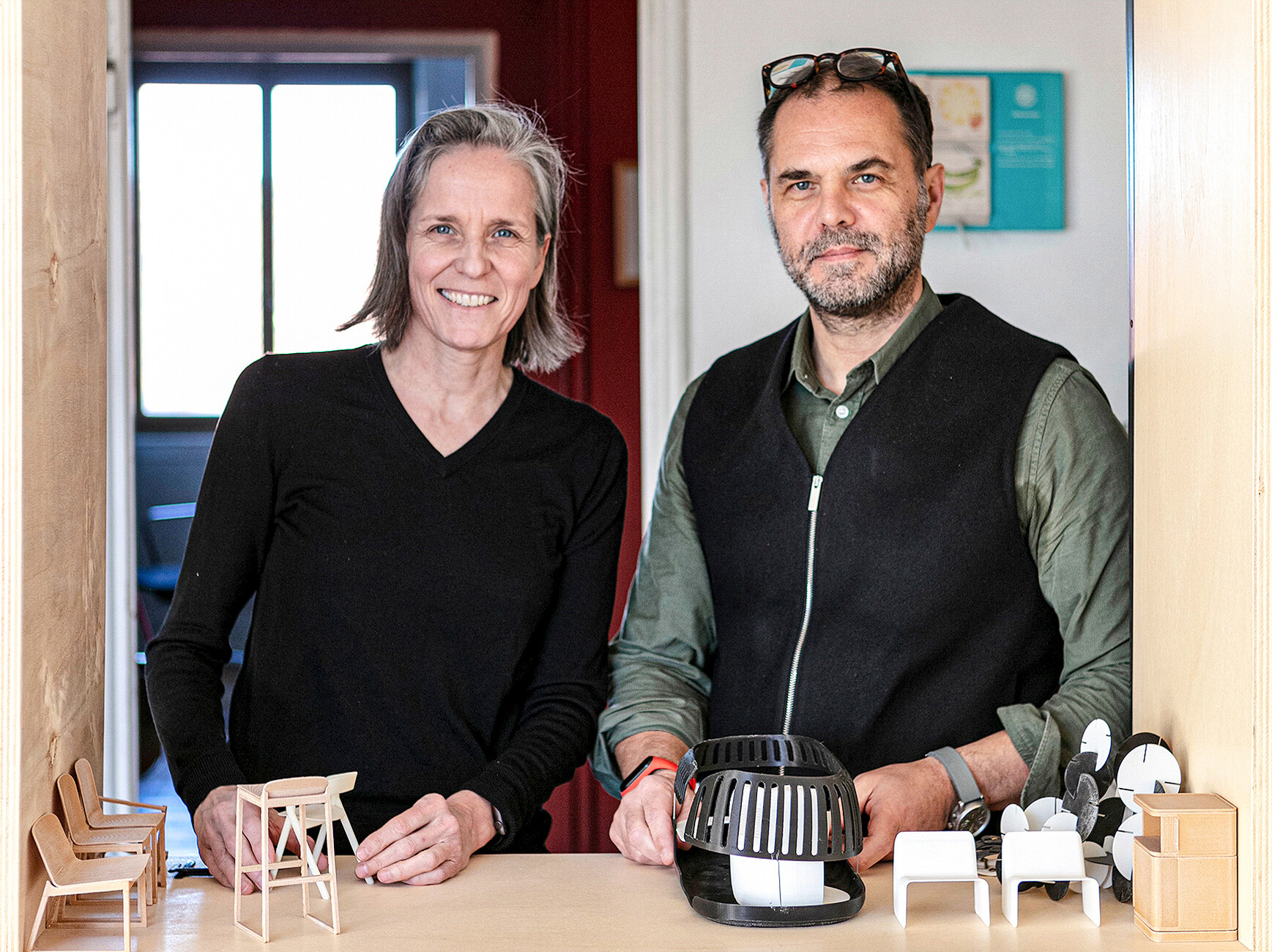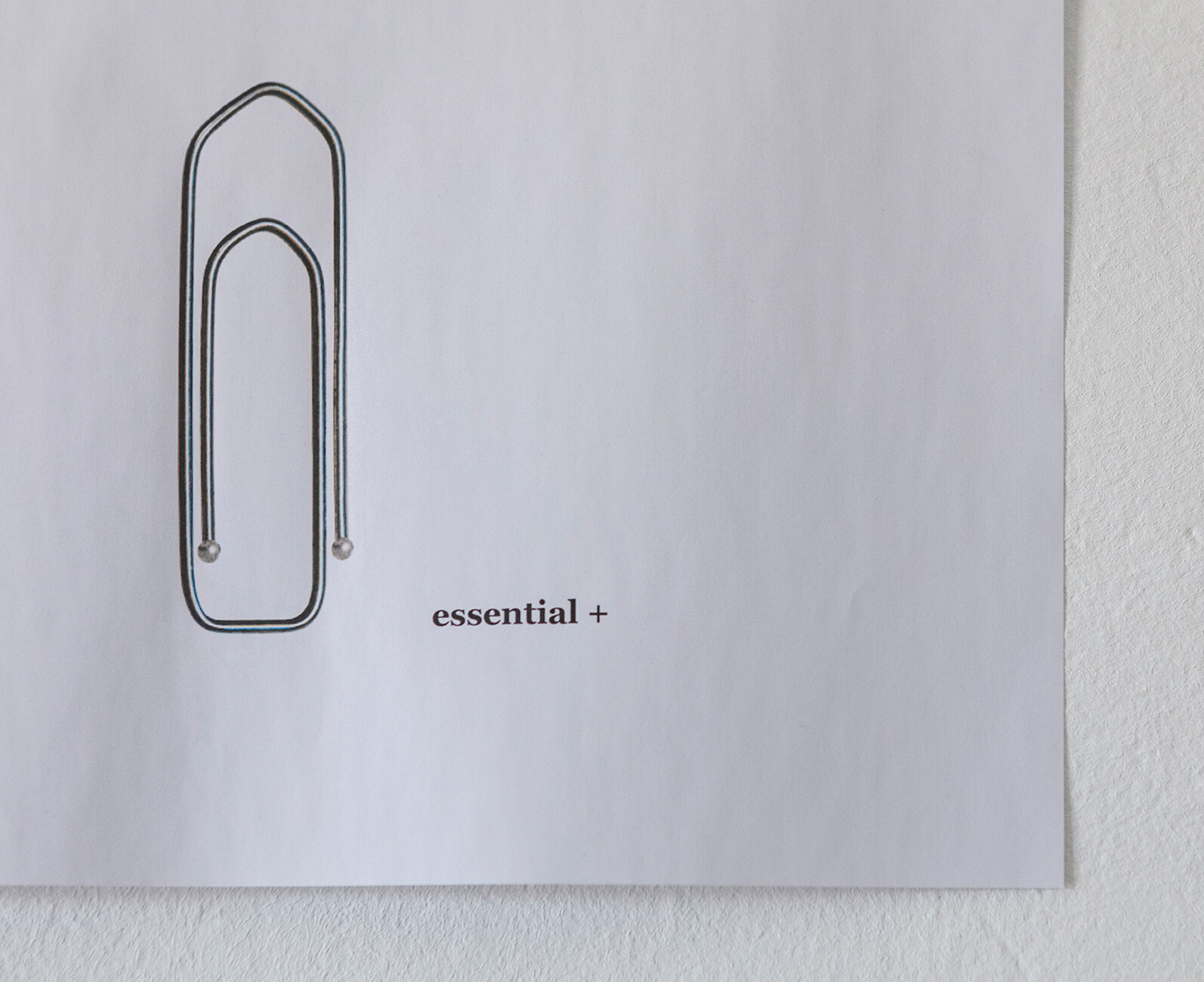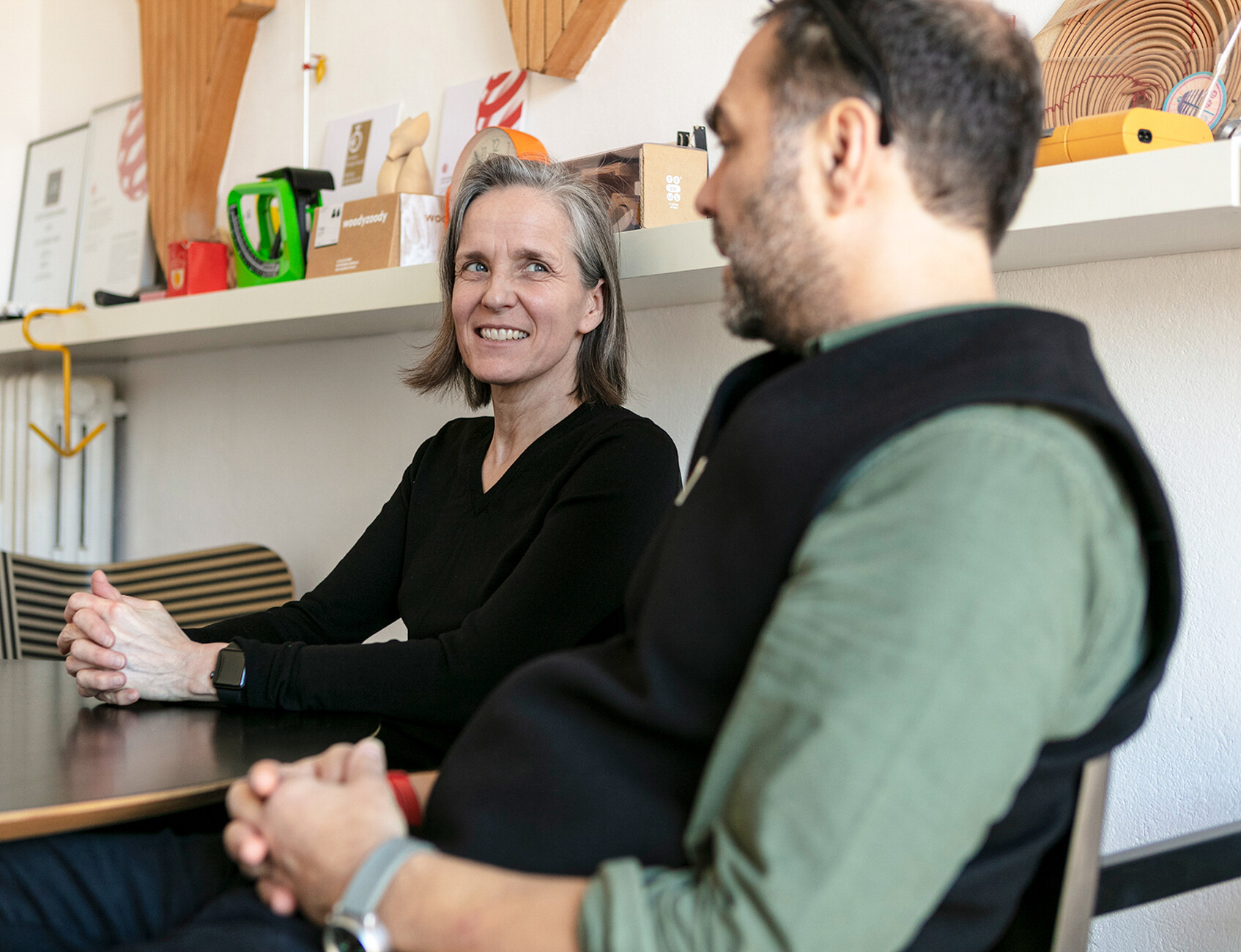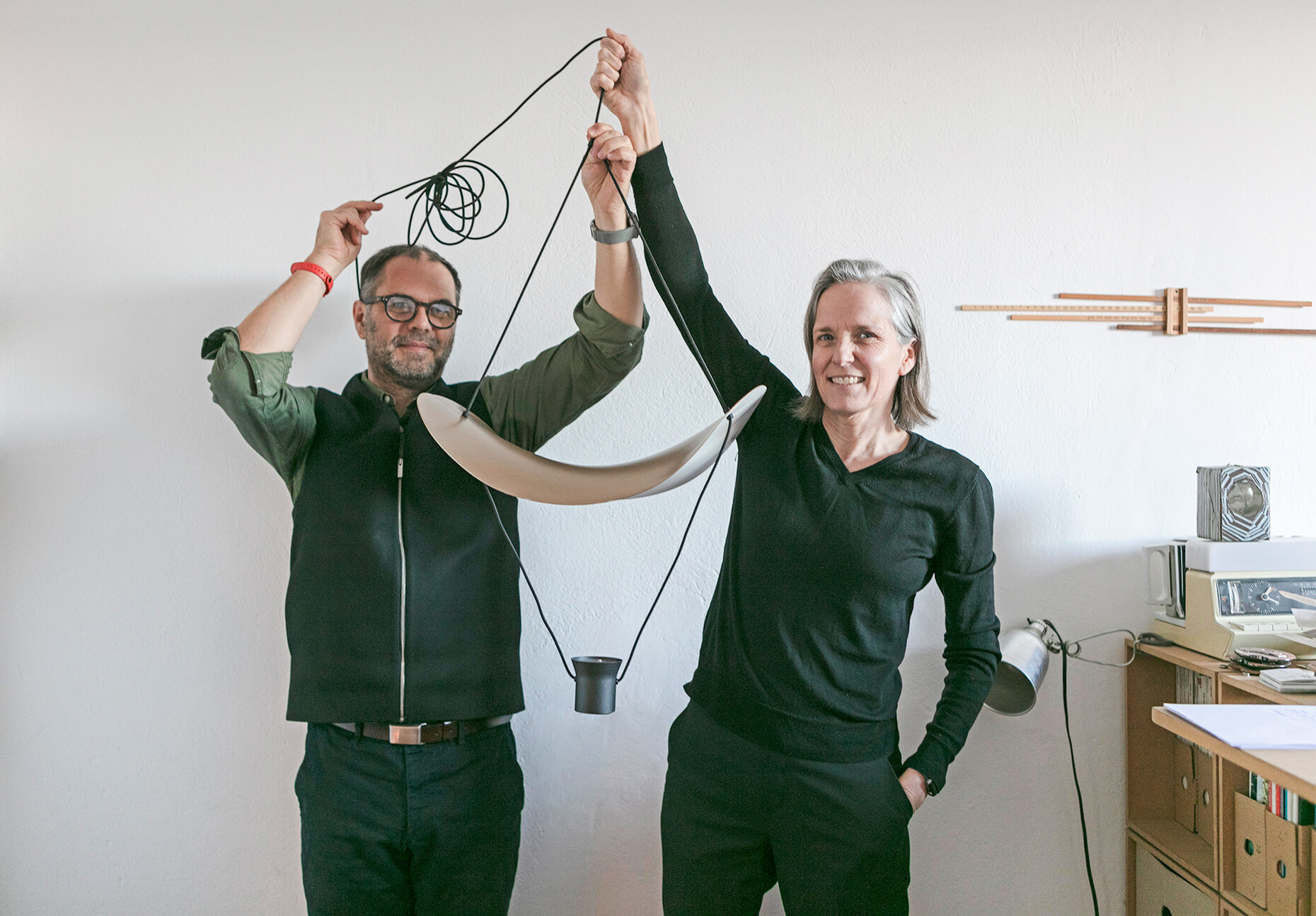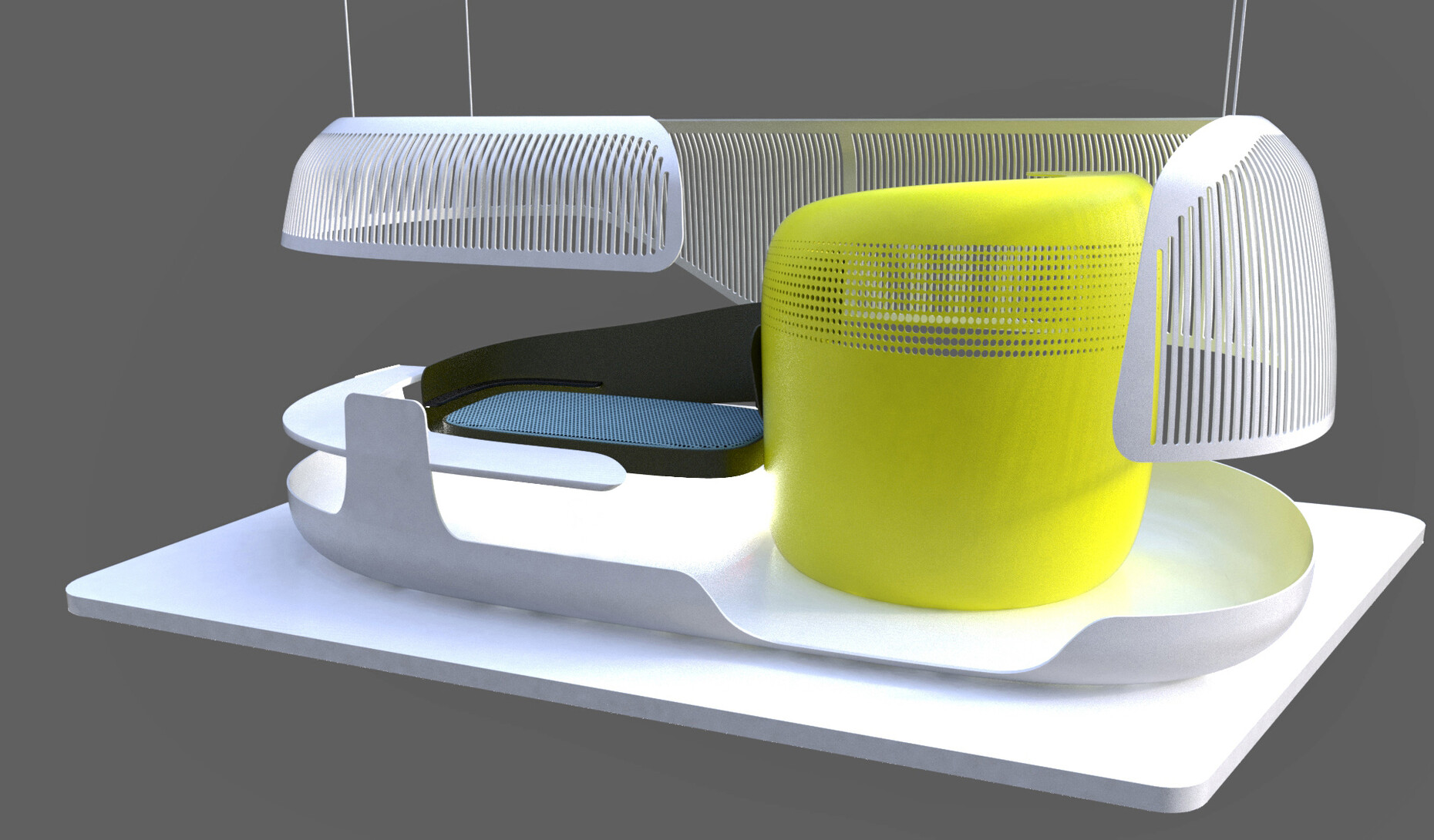Portrait
That bit extra
Two white A4 pages that each show a paperclip. At first glance they seem identical, until you realize that the open ends of one are fitted with tiny balls. It’s a detail that adds a special note to the linear design. “Essential” and “Essential plus” are the names given to these twin paperclips displayed on one of the walls in the Lorenz + Kaz studio in Milan. Finding that little bit extra is a key goal for industrial designers Catharina Lorenz and Steffen Kaz. Their products, predominantly chairs, are designed to be functional and boast an aesthetic you would immediately associate with Scandinavia, were it not for the playful element, the snappy yet practical little bit extra that gives the designs their unique character. A prime example is “KATO” for Artifax, the silent butler that can quickly be put in position to serve as a tray, clotheshorse or seat. Or “TRIA” for Colé, the seat of which consists of three assembled elements that allow for a straight or sideways sitting position. Dynamic lines in the design produce a look that is reminiscent of the impossible drawings of M.C. Escher. “The important thing is to distill the idea down to its essence and then breathe life into it,” says Steffen Kaz. The breakthrough for the pair came shortly after they made the leap and went freelance with “Aspetto” in 2002, an in-house production the design duo created for the talent show at imm cologne. Cut from a single sheet of aluminum and curved in a continuous line to create an aesthetic form, “Aspetto” offers a convenient place to sit. A small work surface and storage space under the seat complete the concept. “You can still make a big statement with a simple design,” comments Catharina Lorenz. Given today’s flexible work environments, this multifunctional waiting-room piece was well ahead of its time at the start of the millennium. Shortly after its launch, Lorenz + Kaz shifted “Aspetto” to the smallest stand at Orgatec that year. In spite of its minimal presentation in a booth barely seven square meters in size, the model attracted the attention of US manufacturer General Motors, which then granted the designers their biggest commission yet, ordering 4,000 items for the Cadillac Experience Corner.
Future living
The duo’s consistent consideration of people and their quality of life within their designs is also evident in their current projects: Together with Containerwerk Stuttgart and Esslingen University of Applied Sciences, they are now refining a modular housing concept for living in old age: It’s a set-up that can be adapted flexibly to the sort of physical impairments that people most frequently face in this stage of life. The starting point: mini-apartments of a mere 22 square meters in converted containers, which can either stand alone or be attached to existing buildings. Sensors integrated into the walls, floors and furniture help to monitor the resident’s state of health, while practical handles and aids for mobility are integrated into the furniture items. “The concept is all about future living,” says Catharina Lorenz. Within the project, particular emphasis is placed on the compact bathroom unit: With shower, sink, WC, lighting, storage space and wide doorways, it still fulfils all the required functions despite being pared down to the essentials. “The unit prolongs an older person’s autonomy by providing a barrier-free space that can be adapted to the resident’s medical requirements,” explains Catharina Lorenz. Here, the homely look is like that of any modern bathroom: Nothing is reminiscent of the cool, unappealing mint green and beige color scheme found all too often in standard healthcare facilities. It’s a new niche Lorenz + Kaz aim to fill.
Specialists, not generalists
The bathroom modules are produced using Solid Surface, a mineral material that can be heat-molded and is therefore easy to work with. The 2.80 meter long and 1.10 meter deep unit can subsequently be fitted seamlessly into the container apartments. In parallel, Lorenz + Kaz designed a showroom for Durasein, one of the biggest manufacturers of Solid Surface in China: the space boasts 1,000 square meters and is located in Zhuhai in the south of the country. The projects exemplify the designers’ flexible approach, whereby they bring their wealth of expertise from product design through to installation to bear in a single project. The pair’s creative process is based on communication: “We discuss everything with each other, and this often leads to us discerning new opportunities,” Steffen Kaz suggests. The inspiration for maintaining this kind of dialog came from their teacher, James Irvine. He was with Steffen Kaz when the latter visited the studio of Ettore Sottsass in the early Nineties – Catharina Lorenz was working there at the time. Milan has always remained a home port in Lorenz + Kaz’s shared trajectory, even if it hasn’t always been easy to gain a foothold in the existing creative circles of the design metropolis. “Life here is a bit more improvised, but very human, which I’ve learned to appreciate,” says Steffen Kaz. The Italian influence has also come to be reflected in their designs: “The broad spectrum of colors and materials in the country has undoubtedly had an impact,” says Catharina Lorenz.
For their studio, they converted an apartment in Milan’s Cittá Studi district – complete with a small workshop and two office rooms. The seating includes many of the designs they produced themselves, including “Calu”, a solid wooden chair and the result of their first collaboration with Zeitraum. Analog and digital go hand in hand in Lorenz + Kaz’s creative process, and it shows on the designers’ desks: Sketches are piled up alongside the graphics tablet, while handmade prototypes stand alongside versions from the 3D printer. The little things, from notebooks to material samples, are assembled in the “Piu Console”, a design produced for De Padova, and in the “Cling” shelf units created for Colé. Indeed, Lorenz + Kaz were instrumental in shaping the design idiom of Italian label Colé from the outset. They helped to develop the creative direction to be pursued by this young brand, which was founded by architect Matteo De Ponti together with Laura Macagno in 2011. “For us, it’s important that a company pursues one style and doesn’t try to be too generalist,” says Catharina Lorenz –with the aim being, of course, to always achieve that something extra that makes the result so special. That applies to the unusual “Opto Folding Screen”, for example, or the “Secreto Coffee Table”, which boasts two levels and thus bridges the divide between coffee table and book stand. Flexible and multifunctional: These are the two qualities inherent in the designs by Lorenz + Kaz. “Design ‘d’auteur’ is not really our thing; we like to consider people and their quality of life,” says Catharina Lorenz. These are the qualities that also convinced the high-profile politicians at the G7 summit, who debated from the comfort of slightly modified versions of the “Coco” armchairs by Lorenz + Kaz back in 2015.
Their philosophy and their courage to embark on a path of their own are attributes the designers are now passing on to the next generation: Steffen Kaz has taught for many years as a lecturer at the University of Bolzano, currently he teaches at the Nuova Accademia di Belle Arti in Milan and regularly gives workshops. “You should never stop listening to your own instincts to help you find themes that drive you,” he says.
